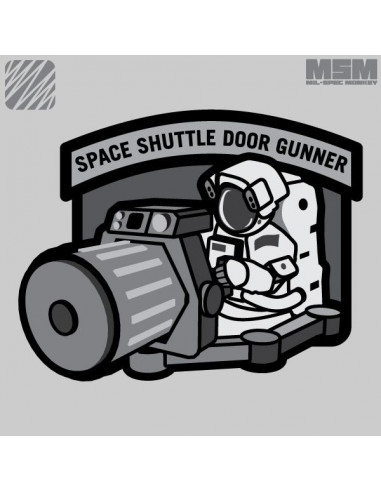[Source for the Art](The source for the art: https://twitter.com/konwashi_2/status/1849000087248376017)
2066
Stationed on Mars to quell a rebellion
Become side door gunner for atmospheric dropship.
No miniguns or gatling cannons, just some metal brick with a pipe on one end.
Get sent in to extract some wounded.
Reach the evac zone and come under attack.
Hoard of rebels charging in with their new plasma guns and compact rocket launchers.
Let loose a stream of bullets.
The sounds of the rebel’s screams are nearly drowned out by the heavy “Kachunk chunk chunk chunk” of the machinegun.
The wounded are loaded up and returned to base.
Inspect MG afterwards.
Thing was made in 1942.
Tunisia, Italy, and Germany are scratched onto the gun.
Scratch “Mars” on with a knife.
I would love to keep reading this story
I feel like the recoil due to low gravity and no atmosphere on the moon would make heavy firepower guns extremely hard to use
You forgot Vietnam, Iraq, Afghanistan, (and by 2066) China.
lol, that copy pasta
It’s a classic
Screenplay, please!
Gunpowder is self oxidizing when ignited. As long as they used a non-evaporating lubricant on the actual mechanical components like graphite, and included a barrel liquid cooling loop, the M2 would operate totally fine in space.
Now I want to see a space-ready heavy machine gun with a big radiator attached
What about barrel cooling? Getting rid of heat is a major challenge in a vacuum.
That’s why I say you need to provide a closed liquid coolant loop around the barrel that would ve integrated with your ship’s heat management system, to replace the air cooling of the barrel.
https://en.wikipedia.org/wiki/M2_Browning
The development of the M1921 water-cooled machine gun which led to the M2, meant that the initial M2s were, in fact, water-cooled. These weapons were designated Browning Machine Gun, Cal. .50, M2, Water-Cooled, Flexible.
space ready since 1933! We really were ahead of our time!
you need to provide a closed liquid coolant
Will the blood of my enemies suffice?
A little thick, but good enough.
Sugar is almost as corrosive as salt, so please make sure your enemies are on a sugar- free,salt-free diet, i.e., dying, saving you the trouble.
Way ahead of you there!
Only if they are cold blooded
to replace the air cooling of the barrel.
radiators work in space, just not as efficiently. fill 'em with ammonia, put more fins on for larger surface area, I’m sure the M2 could be adapted.
https://en.wikipedia.org/wiki/External_Active_Thermal_Control_System
no because without gravity to pull them back down your bullets would just keep going up and up and over whatever you’re trying to hit
Bullets don’t inherently go up when fired, they go straight out of the barrel, the barrel is just inclined because of the sight alignment. You just realign the sights, this isn’t a difficult problem.
Bullets don’t inherently go up when fired
yeah because of gravity
get rid of all the gravity and they’ll go straight up
No.
don’t come crying to me when your bullets go up so much they do a full loopdeloop and shoot you in the back of your head because you tried to fire them on the moon where there’s no gravity
But actually, if you had no gravity acting to change the velocity vector, the bullet would continue in a straight line. If you shot at the horizon it would be like drawing a straight line tangent to a circle. The bullet’s not going to end up going in the shooters azimuthal direction, but it sure is going to gain altitude as the curvature of the body peels down way away from the straight line it’s flying,
I bet all of them make a loud wooshing noise as they head straight up from the moon to earth.
you seem like an expert in moon warfare
just blow on it
A closed loop wouldn’t work probably. You’d need an open loop, or a shit ton of radiators. I guess potentially it could couple to the ground and sink heat into it, but you’d need to be stationary.
See also Brigador: apart from the various lasers, exotic ballistics, and nightmarish chemical weapons it includes, there’s also the prosaic “Mãe Dois.” The tech entry leaves no doubt about what it is:
You have the Heavy Stubber in 40 k too!
Brigador has such a cool aestetic
Once fired, the bullets would just retain their muzzle velocity.
I don’t know what kind of muzzle velocity increase would happen – no air means that they’d be moving somewhat-faster. I’d think that that’d depend on a number of things, probably fluid dynamics and stuff. But maybe you can back-of-the-napkin it by figuring that any acceleration is roughly bounded by the energy required to accelerate the mass of air involved to muzzle velocity. I don’t know exactly how much air that is. Certainly the air inside the barrel, but also some of the air outside the muzzle.
https://en.wikipedia.org/wiki/Density_of_air
Air has a density of approximately 1.225 kg/m 3 (0.0765 lb/cu ft)
https://oow-govmil.com/firearms/50-m2hb-qcb-2/
Barrel Length – 45 inches (114.3 cm);
https://en.wikipedia.org/wiki/.50_BMG
Bullet diameter: 12.98 mm (0.511 in)
So that’s about
(.511/2)^2*3.1415*45=9.22850 in^3, or 0.00015122811 m^3, so .00018525 kg, so 0.1g of mass of air in the barrel.https://barrett.net/products/accessories/ammunition/50bmg/
Bullet Weight: 661 gr
~15.4g per grain, so ~43 grams. So I figure that the mass of the air in the barrel probably isn’t a huge factor, and I don’t know how to compute the effective amount of air that needs to be accelerated outside the barrel and how much…that’s probably a fluid dynamics question .
Let’s just say that it’s three times that amount of air. Even if so, that’s a pretty miniscule factor compared to the mass of the bullet, like under half a gram. So I figure that the muzzle velocity probably isn’t all that much higher in space.
Are we moving fast enough to do much in terms of orbit change?
https://en.wikipedia.org/wiki/Low_Earth_orbit
The mean orbital velocity needed to maintain a stable low Earth orbit is about 7.8 km/s (4.8 mi/s), which translates to 28,000 km/h (17,000 mph). However, this depends on the exact altitude of the orbit. Calculated for a circular orbit of 200 km (120 mi) the orbital velocity is 7.79 km/s (4.84 mi/s), but for a higher 1,500 km (930 mi) orbit the velocity is reduced to 7.12 km/s (4.42 mi/s).[10] The launch vehicle’s delta-v needed to achieve low Earth orbit starts around 9.4 km/s (5.8 mi/s).
https://www.gd-ots.com/wp-content/uploads/2017/11/M2HB-50-Caliber-Heavy-Machine-Gun.pdf
Muzzle velocity: (M33) 3,050 feet per second (930 meters per second)
Hmm.
Depending on T/W and other factors, delta V to LEO can vary. But once you’ve reached LEO, gravity loss and atmospheric drag are no longer factors. So I’ll give you some delta Vs going from a 300 km altitude circular orbit to higher altitude orbits.
300 km to 500 km - .11 km/s
300 km to 1000 km - .38 km/s
300 km to 2000 km - .83 km/s
300 km to 4000 km - 1.51 km/s
300 km to 8000 km - 2.37 km/s
300 km to 16000 km - 3.22 km/s
300 km to 32000 km - 3.83 km/s
300 km to 64000 km - 4.1 km/s
300 km to 128000 km - 4.13 km/s
300 km to 256000 km - 4.02 km/2
300 km to 512000 km - 3.87 km/s
300 km to 1024000 km 3.72 km/s
So, the International Space Station is at 340 km. So figure that our astronaut is acting as gunner on a vehicle in LEO at 300 km, can use the above table.
The upper end of LEO is 2000 km.
So you’ve got about 1 km/s in terms of delta V to work with there. So if our astronaut is acting as roof gunner on a Humvee in LEO, that’s actually quite a lot of ability to reach. Given sufficiently-accurate aim, and maybe willingness for a bullet to do a sufficient number of orbits before it collides with a target, he’s got the range to hit anything in low earth orbit.
He can’t hit GPS/Galileo/GLONASS satellites (19k km to 23k km). And he can’t hit escape velocity, so that Model S that Elon Musk launched into an eccentric path wandering the solar system is probably safe. But he can hit a lot of stuff.
Okay, the image is of the Moon. How about acting as a gunner there?
https://nssdc.gsfc.nasa.gov/planetary/factsheet/moonfact.html
Escape velocity: 2.38 km/s
No. From the surface of the Moon, his bullets are going to come back to the Moon. So he can fight lunar battles, but he can’t be engaging targets on other celestial bodies or in their orbit, like the Earth.
He can’t hit GPS/Galileo/GLONASS satellites (19k km to 23k km). And he can’t hit escape velocity, so that Model S that Elon Musk launched into an eccentric path wandering the solar system is probably safe. But he can hit a lot of stuff.
Assuming the M2 has some kind of absurdly precise, even more advanced than a CIWS mechanical aiming mount and traverse system , connected to some kind of orbital trajectory calculator computer system, as well as a system that knows its own precise location, and trajectory and velocity, and the exact location and velocity and trajectory of his target… (you know potentially on the other side of the fucking planet, moving at about Mach 28 or 30)…
…suuure.
Otherwise, no, the M2 will only be hitting things within visual distance, which are also travelling at a velocity and trajectory pretty darn similar to his own.
Major concern here for LEO engagements is that any shots that miss are a liability coming back to hit the gunner.
Basically once a bullet’s fired, a new orbit is defined for that bullet, a new elipse can be drawn. That now elipse is constrained by the position and direction of that bullet the moment it’s fired. Unfortunately that means that one bullet orbit later the bullet is going to be in the exact same position with the exact same velocity. The gunner had better hope that orbit phases are misaligned.
Shooting at targets in the retrograde direction might be safest, they’re more likely to dip into the edge of the atmosphere and start to lose a bit of velocity ensuring they never come back.
Did you compute for air in the barrel after calling out there was no air in space? Just curious about that, s’all.
With that, there would be a hell of a suction on the bullet after the cartridge was fired. Also, the detonation doesn’t happen all in one go and continues as the bullet moves to the muzzle. (I did quite a bit of experimenting with that to reduce muzzle flash, actually.) So, the bullet is accelerating until the pressure is released when the bullet passes the muzzle.
While air in the barrel isn’t really a factor on earth, surrounding air pressure absolutely is. It affects burn rate most but how it affects burn rate is a characteristic of the powder itself. (In zero-G, I would speculate a slower burn because the powder would be more prone to floating if it wasn’t a compressed load.)
When I plan to go to lower altitudes, I typically use lighter loads or I risk over-pressure conditions. (I’ll basically just compute for a couple hundred pounds less pressure chamber.)
After all that, I have no fucking clue what would happen in space because the conditions are so wonky.
Did you compute for air in the barrel after calling out there was no air in space?
Yes. What I’m looking for is to try to figure out what the increase in muzzle velocity in space is based on relative to a known muzzle velocity on Earth in air.
I admire your dedication to the math but isn’t that all kind of irrelevant? No oxygen means no explosion when the firing pin strikes the cartridge which means your projectile remains stationary.
Edit: I just saw that other guys comment on this very topic. I don’t know if he’s correct but it’s at least plausible enough to make the topic worth exploring. Please carry on.
He’s correct. You can fire firearms underwater for the same reason (though you can also destroy weapons doing so, not something to casually do).
The year is 2734. Humanity has conquered death, cured every disease (even the common cold), and colonized the stars. Yet on battlefields from Earth to Europa, the M2 Browning still thunders, the BUFF rumbles through alien skies, the M1 Abrams fires its 120mm cannon, and every Marine is issued a KA-BAR.
reminds me of the best patch I’ve seen in a long time - Shuttle Door Gunner

So… I don’t see that anyone’s brought this up yet so here goes:
If we are talking space space, you know, in orbit, transiting between planets…
You have to account for the recoil of each shot potentially sending your craft into a rotational spin, which can alter its trajectory.
Depending on the mass of your firing platform, you may have to expend a considerable amount of monoprop fuel, or energy in batteries to run multi axis centrifugal stabilizers…so that you maintain your desired trajectory.
Also, even if you are not in space, but on a moon or planet with significantly lower mass than earth… you’re gonna have to do extra work to keep your tripod from dislodging from the ground, even knocking you backward with a sustained burst.
It might not even be practical to do a sustained burst or sweep, it might end up making sense to mod a slower cyclic rate into the thing, jerry rig a Kriss Vector counter weight style contraption to lower recoil.
Basically, the weight of everything involved goes down as G goes down… but the recoil energy remains the same… if you are in 0.5 G, basically, the recoil is twice as intense, as its pushing against half as much weight.
Each single shot would be more precise and travel farther in a vacuum or thin atmosphere and lower G… but sustained fire would be less accurate.
…Or maybe I’m overstating this effect? I’m too tired and lazy to attempt the actual physics calculations for recoil force.
All these problems are solved by firing two M2’s in opposite directions, a net positive for everyone involved.
Well that is insanely stupid, but it would net the recoil out to 0, if they are perfectly aligned…
Brilliant!
I like this idea better than the recoilless rifle conversion I was thinking about.
Simple, effective.
Gyrojet ammunition has entered the chat.
The space shuttles were originally designed with 6 M2s mounted in the wings. It was mostly a tradition thing, but they cut the armament to save weight or something stupid. Fast forward to the Columbia disaster, and where does the fatal foam piece strike? Right in the firing line of old ma deuce.
recoil should be fun












